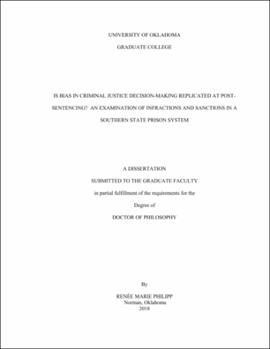| dc.description.abstract | An abundance of research suggests that demographic differences in criminal outcomes are prevalent at many stages of the criminal justice system (e.g., arrest, prosecution, conviction, and sentencing). For instance, males are 1.7 times more likely than females to be arrested, and they are also 2.5 times more likely than females to receive a prison sentence. Disparities are also evident by race. Blacks make up 13 percent of the U.S. population, but account for 42 percent of those imprisoned. Blacks also tend to receive longer prison sentences than white offenders. Research has suggested that legal factors (e.g., crime type) cannot always account for these group disparities and that extralegal factors such as race and gender impact the legal decision-making process as well. Although much is known about how race and gender assert an influence on various justice outcomes, there remains a gap in the literature regarding the replication of biased decision-making at a later stage of the criminal justice process: post-sentencing.
Using a sample of 2012 and 2013 prisoners released from a Southern state prison, this study examines the influence of an inmate’s race and gender on prison officials’ decision to issue an infraction as well as the influence of these extralegal factors on the type of sanction prison officials impose for the infraction. Findings from a series of logistic regression and generalized linear mixed models demonstrate that there are race and gender disparities in who receives a formal prison infraction. Sanction outcomes for these formal infractions, however, suggest that race and gender do not assert an influence. Rather, factors that account for variation in sanction outcomes are related to the characteristics of the infraction, characteristics that describe why the inmate is serving time in prison, and the security level of the sanctioning facility. | en_US |
